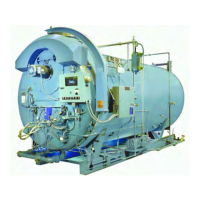Chapter 6 — Adjustment Procedures
6-4 Part No. 750-184
Burners). In this position, fuel delivery is at low fire rate. Tighten the
set screws to secure the cams on the jackshaft.
Refer to Figure 6-2. The stop screw in the rotary air damper limits
damper travel at both closed (low fire) and fully opened (high fire)
positions. The screw is provided so that it is possible to tell, even
with the burner is in place, whether the damper rotor is in fully
opened or closed position. Rotating the damper clockwise to the
stop screw opens the damper. Rotating the damper
counterclockwise to the stop screw closes the damper. Normally,
the rate of flow of air through the damper with the rotor in low fire
position is about one-third of maximum for a standard burner.
The amount of angular movement controlling the rate of air flow is
determined by the location of the ends of the rotary air damper rod
in both the jack shaft arm and the air damper arm.When the air
damper is in low fire position, the jackshaft arm should be at 45°
and the rotary air damper arm should be at an angle of
approximately 60° below the horizontal (Figure 6-1). This will
ensure that the angular movement of the damper starts slowly,
increasing in rate as the high fire position is approached.
Prior to initially firing a boiler it is advisable to check for free
movement of the linkage. The damper motor must be allowed to
complete its full stroke and the damper must move freely from low
to high fire position. Adjustment of linkage connected to a gas
butterfly valve is described in Section Q of Chapter 6.
C. MODULATING MOTOR
The modulating motor has a 90° shaft rotation. The motor
manufacturer also provides a 160° stroke model for other
applications. If a replacement is obtained from someone other than
a Cleaver-Brooks Service or Parts representative, it may have an
incorrect stroke. To prevent damage, determine the 90° stroke
prior to installing a replacement.
The stroke may be determined by powering the motor and
connecting terminals R-B to actually determine the stroke as motor
drives to an open position.
D. MODULATING MOTOR SWITCHES - LOW FIRE AND
HIGH FIRE
The modulating motor contains either one or two internal switches
depending upon application. The microswitches are actuated by
adjustable cams attached to the motor shaft.
Note: If the boiler is equipped with the CB-Hawk ICS, there are
no end switches. Do not attempt to adjust the
Modulating Motor if the unit is equipped with the CB-
Hawk ICS
Factory replacement motors have the cams preset. The low fire start
switch is set to make the red and yellow leads at approximately 8°
on motor closing. The high fire purge air proving switch (located in
Figure 6-2
JACK SHAFT
ROTARY AIR
DAMPER ARM
ROTARY AIR
DAMPER
STOP SCREW
DIFFUSER PLATE
DAMPER ARM
Figure 6-3
1. ADJUST THE LINKAGE TOWARD
THE
DRIVE SHAFT FOR LESS
MOVEMENT
.
2. ADJUST AWAY FROM THE DRIVE
SHAFT
FOR MORE LINKAGE
MOVEMENT
.
1
2

